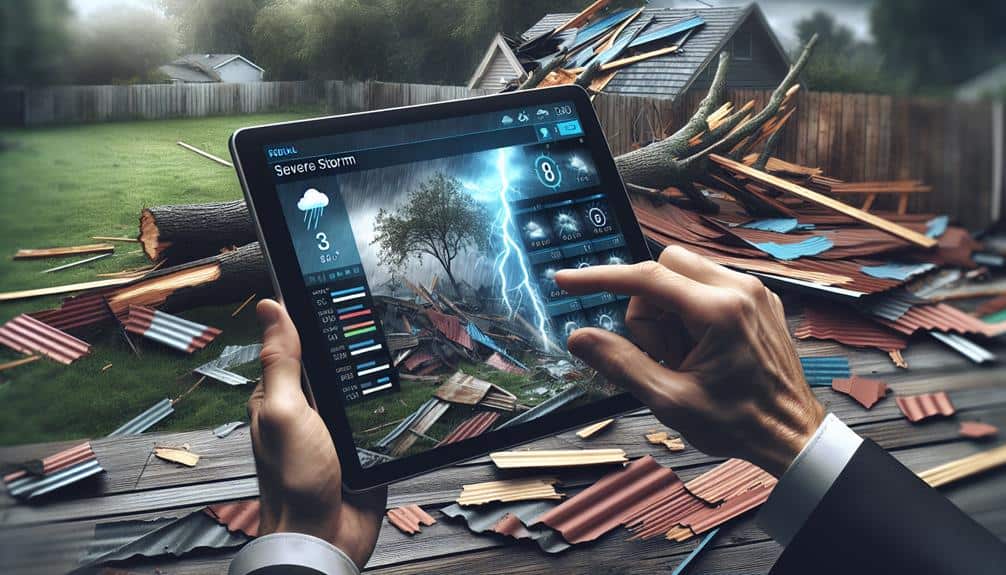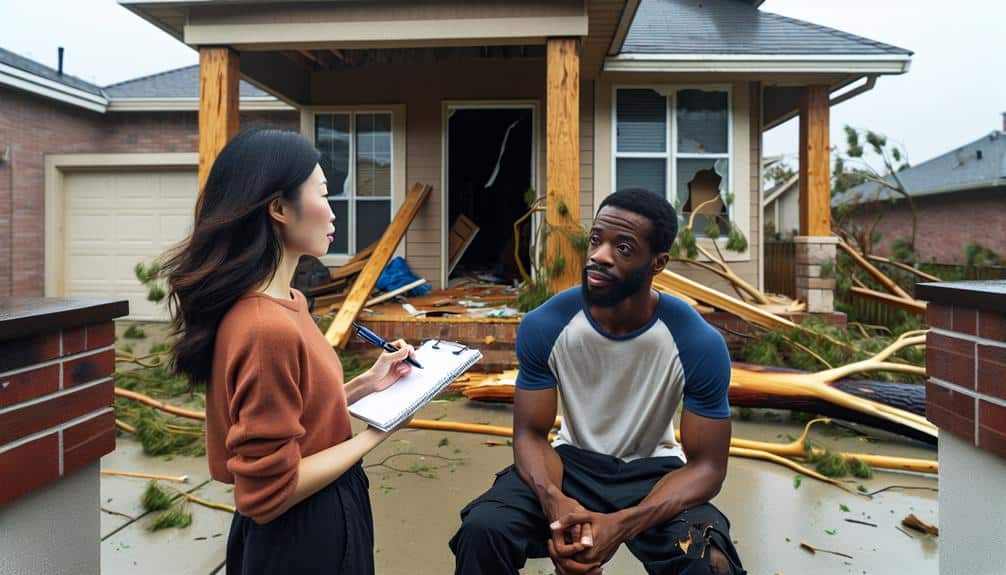When it comes to documenting storm damage repair, let's begin by taking clear photos from multiple angles and complement them with video evidence and detailed notes. We'll capture date and time, highlight specific damage, and save accurate weather reports. Creating a damage map and securing witness statements will provide additional context and support. It's essential to document immediate repairs, keep all receipts, and organize them meticulously. Finally, having digital backups guarantees everything is easily accessible. Each of these steps will aid in making thorough and accurate records, guaranteeing a smooth repair and claims process. Learn more to fully grasp the details.
Key Points
- Take high-quality photos and videos from multiple angles to clearly capture the extent of the storm damage.
- Keep all repair receipts and organize them by date to support insurance claims and expenses.
- Use timestamped photos and videos to provide a clear record of when the damage occurred.
- Collect and document detailed witness statements, including signatures and dates, to support your claims.
Take Clear Photos
One of the most important steps in documenting storm damage is to take clear, high-quality photos of the affected areas. We need to make sure our photos capture the extent of the damage from multiple angles. This helps create a detailed visual record that supports our insurance claims and guides the repair process.
When we're out in the field, it's important to take into account the weather conditions. Take photos as soon as it's safe to do so, making sure that the light is adequate to show details clearly.
In addition to photos, we should complement our documentation with video documentation and detailed notes. Videos can capture broader perspectives and provide context that still images might miss, while detailed notes can describe the specific damage, such as the type of materials affected and the location of each issue.
We should also link our documentation to a repair timeline. By noting the date and time of each photo and video, we can track how conditions evolve over time and align our repair efforts accordingly.
This thorough approach guarantees that we're fully prepared when discussing our claims and repair plans with insurance adjusters and contractors.
Use Video Evidence
Why rely solely on photos when video evidence can provide a detailed view of storm damage? Videos capture the extent and severity of damage in real-time, offering a dynamic perspective that still images simply can't match.
By using video documentation, we can walk through the property, highlighting specific areas of concern and providing a thorough view that's invaluable during property assessment.
Video evidence allows us to narrate the damage, pointing out critical details that might be overlooked in photos. We can zoom in on problem spots, pan across wide areas, and record audio commentary to contextualize the visual information. This approach not only offers a comprehensive documentation but also facilitates clear communication with insurance adjusters, contractors, and legal professionals.
Moreover, video documentation carries significant legal implications. In the unfortunate event of disputes over claims or repairs, video evidence can serve as a powerful, credible record. It's harder to contest a continuous, unedited video than a series of isolated photos.
By incorporating videos into our documentation process, we establish a strong foundation for any future legal or insurance-related issues.
Ultimately, using video evidence empowers us to provide a meticulous and transparent account of storm damage, ensuring we can confidently address all aspects of property assessment and repair.
Record Detailed Notes
To supplement our video documentation, we must record detailed notes that capture specific observations and relevant information about the storm damage. This written record helps guarantee that nothing is overlooked and provides clarity that complements our photographic evidence.
By meticulously documenting every aspect of the damage, we can create a thorough account that supports our repair efforts and any insurance claims we may need to file.
When we take notes, we should focus on the specifics: the location and extent of the damage, materials affected, and any immediate safety concerns. Describing the condition of structural elements, such as roofs, walls, and windows, in detail will help create a clear narrative. If certain areas are inaccessible or hazardous, this should be noted for future reference.
Additionally, integrating our notes with photographic evidence is essential. Each photograph should be accompanied by a description that explains what the image shows and how it relates to the overall damage. This way, our recorded details and visual documentation work together to form a complete and precise picture of the storm's impact.
Capture Date and Time
When documenting storm damage repair, we need to capture the date and time accurately. Using timestamped photos helps establish a clear record, while recording weather conditions can provide useful context.
Additionally, noting the repair timeline guarantees we maintain an organized and detailed account of the entire process.
Use Timestamped Photos
Taking timestamped photos is necessary for accurately documenting the extent of storm damage and facilitating a smoother claims process. When we're discussing insurance coverage, having these photos can make all the difference. They provide indisputable evidence that can help us avoid legal implications and make sure we receive the compensation we deserve.
Here are some vital steps for effectively using timestamped photos:
- Capture Before and After Shots: Document the condition of your property both before and after the storm. This helps in clearly showcasing the damage.
- Detail Every Area: Ensure we photograph all affected areas, including roofs, windows, and basements. Thorough documentation is key.
- Use Multiple Angles: Taking photos from various angles allows for a more complete representation of the damage.
- Include Personal Items: Don't forget to document personal belongings that were damaged or destroyed.
Record Weather Conditions
In addition to capturing timestamped photos, recording the weather conditions, including the date and time of the storm, is vital for a thorough damage report. This information provides a concrete basis for weather pattern analysis and evidence authentication, which are pivotal steps in validating our claims.
By meticulously noting the specific weather conditions, we can accurately correlate the storm's impact with the observed damage, thereby strengthening our case.
We should make sure our records include details such as wind speed, precipitation levels, and any other relevant meteorological data. These elements help create a detailed picture that supports our damage assessment efforts.
When we can precisely tie the extent of the damage to the documented weather conditions, it makes it easier for insurers and repair teams to understand the situation and respond appropriately.
Moreover, having a detailed account of the weather conditions aids in repair progress tracking. By comparing the initial state of the damage with subsequent repairs, we can better gauge the effectiveness of the interventions.
This methodical approach guarantees that all parties involved have a clear, evidence-based understanding of the situation, facilitating smoother communication and more efficient resolution.
Note Repair Timeline
Documenting the repair timeline, including the exact dates and times of each repair activity, is vital for maintaining an accurate and detailed damage report. This practice guarantees we've a clear record of the repair progress, which is essential not only for our own reference but also for insurance coverage purposes. By meticulously noting every step, we can easily track contractor communication and manage repair costs effectively.
To capture a thorough repair timeline, consider the following steps:
- Initial Assessment Date and Time: Record when the initial damage assessment was conducted.
- Repair Start Date: Note the exact date and time when the repair work commenced.
- Daily Progress Updates: Keep a daily log of what was repaired, including specific activities and timeframes.
- Inspection Dates: Document any inspections carried out by contractors, insurance adjusters, or local authorities.
Staying detailed and precise in our documentation helps us maintain control over the repair process. It also strengthens our position when discussing repair progress with insurance providers and contractors. Clear records guarantee that there's no ambiguity, facilitating smoother communication and potentially reducing repair costs.
Let's make it a priority to capture every detail accurately, empowering ourselves with information and maintaining our freedom in managing storm damage repairs.
Highlight Specific Damage

Identifying and recording specific harm is necessary to guarantee accurate repair estimates and insurance claims. When examining storm damage, we should focus on detailed documentation, starting with roof leaks. Roof leaks can cause significant internal harm, so we need to photograph and note any water stains, dripping, or structural compromises. Documenting these issues promptly helps us provide clear evidence for insurance adjusters and repair teams.
Next, we must address the flooding aftermath. Flooding can lead to widespread damage, affecting floors, walls, and personal belongings. We should capture images and videos of standing water, soaked carpets, and damaged furniture. It's important to note the extent of water penetration and any visible mold growth, as this information will be crucial for both remediation and financial recovery.
We should also take time-stamped photos and keep a written record of all observed damages. For every specific issue, we need to include descriptions, such as 'water pooling on the living room floor' or 'shingles missing from the northeast corner of the roof.' This level of detail ensures that our repair estimates are precise and that our insurance claims are supported by thorough evidence.
Document Immediate Repairs
Once immediate repairs are underway, we should systematically record every action taken to prevent further damage. This documentation will guarantee that we've a thorough record for both repair verification and the inspection process. By doing this, we can streamline the damage evaluation and claim submission, making it easier to justify the repairs to our insurance company.
To effectively document immediate repairs, we should:
- Take detailed photographs: Capture before and after images of the damaged areas and the repairs made.
- Keep receipts and invoices: Collect and organize all receipts and invoices for materials and services used in the repair process.
- Maintain a repair log: Note each repair action taken, including dates, times, and the names of individuals or companies involved.
- Document communications: Record all communications with contractors, insurance adjusters, and any other relevant parties.
Save Weather Reports

To substantiate our claims and provide a clear timeline of events, we should save weather reports from the time of the storm. Documenting the weather history is vital for establishing the context of the damage. By preserving these reports, we create a solid foundation for our damage assessment and guarantee that our repair process is based on accurate information.
First, let's focus on report accuracy. Accessing reliable sources such as the National Weather Service or reputable weather forecasting services will ensure the reports we save are precise and credible. These reports often include detailed data on wind speeds, precipitation levels, and storm trajectories, which are essential for understanding the extent and nature of the storm's impact.
Next, we can use this weather history to bolster our documentation. When we present a detailed timeline that includes weather conditions before, during, and after the storm, it becomes easier to correlate specific damages to particular weather events. This correlation aids not only in the repair process but also in any insurance claims we might need to file.
Create a Damage Map
Let's create a thorough damage map by clearly marking all damage locations.
We'll use high-resolution photos to capture each area and note specific types of damage.
This approach guarantees we've precise and detailed documentation for repairs and insurance claims.
Mark Damage Locations Clearly
Creating a detailed damage map is essential for accurately documenting storm damage and confirming all impacted areas are addressed during repairs. By marking damage locations clearly, we enhance our damage assessment and streamline the repair documentation process. An effective damage map makes it easier for everyone involved to understand the extent of the damage and prioritize repair efforts.
To create a detailed damage map, we should:
- Use a layout or blueprint: Start with a detailed layout or blueprint of the property to mark the exact locations of the damage.
- Assign specific symbols: Designate specific symbols or colors for different types of damage (e.g., water, wind, structural) to distinguish between them quickly.
- Include notes: Add brief notes or descriptions next to each marked location to provide context and detail about the observed damage.
- Date and time stamps: Confirm that each marked location is accompanied by a date and time stamp to document when the damage was assessed.
Use High-Resolution Photos
We should always use high-quality photos to accurately capture and document the extent of storm damage. High-quality photos are essential for creating a detailed record of the damage, which is crucial for property assessment and insurance claims. By using high-fidelity images, we guarantee that every detail is visible, making it simpler for assessors and insurers to understand the full scope of the damage.
When we document storm damage, it's vital to systematically photograph all affected areas. Start by taking wide-angle shots to capture the overall context of the damage. Then, move in closer to take detailed photos of specific damage points. This dual approach helps create a clear and thorough damage map, showcasing the extent and specific nature of the storm damage.
Using high-quality photos also aids in creating a chronological record of the repairs, which can be invaluable for insurance claims. By maintaining a detailed photo documentation process, we can provide indisputable visual evidence of both the initial damage and the subsequent repairs. This not only speeds up the property assessment process but also guarantees that we receive fair compensation from our insurance providers.
Note Specific Damage Types
To effectively document storm damage, it's important to observe specific damage types and create a detailed damage map. By noting the exact locations and kinds of damage, we can streamline the damage assessment and repair process, ensuring nothing is overlooked.
Creating a damage map involves:
- Identifying Structural Damage: Look for any harm to foundations, walls, and roofs. This helps in prioritizing urgent repairs.
- Recording Water Intrusion: Note areas where water has penetrated. This will guide us in addressing mold and mildew risks.
- Marking Electrical Hazards: Identify any compromised wiring or outlets. Safety first—these need immediate attention.
- Cataloging Window and Door Damage: Broken glass or warped frames should be documented to secure the premises.
Secure Witness Statements

Collecting witness statements plays a significant role in accurately recording storm damage repair. When we approach witnesses, we must use effective interview techniques to make sure we gather reliable information. Open-ended questions help witnesses provide detailed accounts, while active listening confirms our understanding. We should be mindful of validity concerns; verifying the credibility of witnesses is vital. This can involve cross-referencing their accounts with physical evidence or other testimonies to maintain accuracy.
There are important legal implications tied to securing witness statements. These statements can be pivotal in insurance claims or potential litigation. Therefore, it's our responsibility to meticulously document each witness's account, including the date, time, and location of the interview. Maintaining thorough records not only strengthens the credibility of our documentation but also aids in evidence preservation.
It's also advantageous to get witness statements promptly after the storm. Memories can fade, and details may become less precise over time. By acting swiftly, we increase the likelihood of capturing accurate and useful information.
Keep All Receipts
We must keep all receipts related to storm damage repairs to provide proof of expenses incurred. These receipts are essential for supporting our insurance claims and ensuring we receive the appropriate compensation.
Proof of Expenses
Keeping all receipts meticulously organized is vital for proving expenses related to storm damage repairs. By doing so, we can guarantee that every cost incurred is accounted for, making the process of property assessment and repair estimates as smooth as possible.
To stay organized, we should:
- Create a dedicated folder: Whether digital or physical, having a specific place to store all receipts helps prevent loss and confusion.
- Date each receipt: Adding the date of purchase or service on each receipt can help us track the timeline of repairs.
- Categorize expenses: Group receipts by categories such as materials, labor, and equipment to streamline the review process.
- Photograph receipts: Digital backups can be essential if the original paper receipts are lost or damaged.
Insurance Claims Support
Recording all expenses meticulously not only aids in keeping track of costs but also serves as essential support when filing insurance claims. When it comes to storm damage repair, keeping all receipts is necessary for a smooth claim process. We should maintain a detailed record of every expenditure related to the repairs, from contractor fees to materials purchased. This thorough evidence collection guarantees that we've all the necessary documentation to substantiate our claims.
Each receipt acts as a piece of evidence, demonstrating the financial impact of the storm damage. During the claim process, insurance companies require proof of all incurred costs. By presenting organized and accurate receipts, we make it easier for the insurance adjuster to assess our claim, potentially speeding up approval and reimbursement. Additionally, having this evidence at hand reduces the likelihood of disputes or misunderstandings with the insurance company.
We should also consider creating digital backups of all receipts and documents. Scanning or photographing these items ensures that we don't lose essential evidence and can easily access them when needed.
To summarize, thorough evidence collection and meticulous receipt management are vital steps in securing the insurance support we deserve.
Frequently Asked Questions
What Should I Do if My Insurance Adjuster Is Unresponsive?
When our insurance adjuster goes silent, we should first seek legal advice to understand our rights. If that doesn't work, filing complaints with regulatory bodies can push for a response. Let's take action immediately.
How Do I Find a Reputable Contractor for Storm Damage Repairs?
To find a reputable contractor, we should seek contractor recommendations and check online reviews. Let's ask for referrals from friends and family, and conduct thorough background checks to guarantee their credibility and past performance.
Are There Any Apps That Can Help With Documenting Storm Damage?
We're drowning in a sea of incredible apps for documenting storm damage. They offer photo inventory and virtual assessments, making it easy to capture and organize everything. Let's embrace these tools to streamline our repair process efficiently.
How Can I Ensure My Claim Is Processed Quickly?
To guarantee our claim is processed quickly, we should focus on effective communication with the insurance company and prioritize time management. Promptly submitting detailed documentation and staying responsive to requests can expedite the claim processing.
What Steps Should I Take if My Claim Is Denied?
Imagine a door closing, but another one opens. If our claim is denied, we should immediately start the claim appeal process and explore our legal options. It's essential to act swiftly and seek professional advice when necessary.


